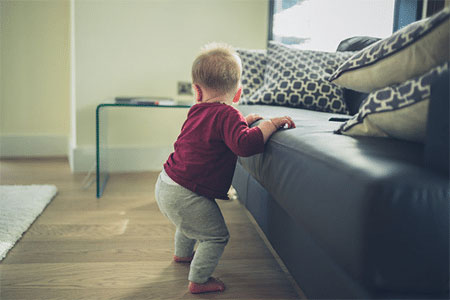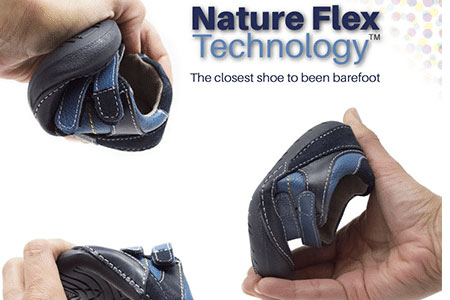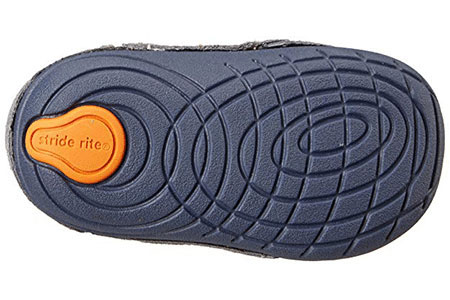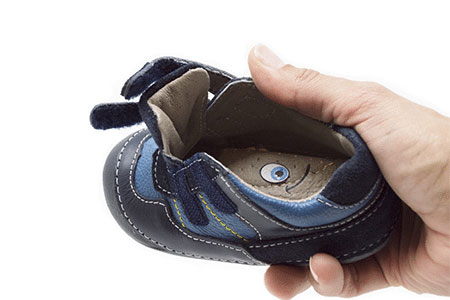What Shoes Help a Baby Walk? – Allow Your Baby to Take Those First Steps with Confidence!

Is your baby cruising and attempting to take his or her first steps? Do you want your baby to be able to take those first steps with confidence? When babies start cruising (this usually starts between 8 and 11 months) it means that they can move side to side by holding onto furniture, and cruising is the last step on the journey of walking independently. As soon as your babies start cruising and taking some steps independently, it’s time to start thinking about which shoes you will provide for their feet.
If you are in a rush, you can go directly to the selection of the best first walking shoes for babies.
About Baby Shoes – Things to Consider
Certain first walking shoes are better than others, as some of them provide sensory pods on the bottom that allow the baby to feel the ground, allowing your baby to feel more stable and confident when taking those first steps. Your baby’s shoes need to come with a rounder toe-box that doesn’t constrict toe movement, as babies move their toes as a way of exercising their feet.
I know exactly which first walking shoe styles are better for a baby that is learning how to walk as I have fitted hundreds of babies for their first pair of walking shoes.
Did you know that providing babies with the correct type of shoes in the correct shoe size will help them take those first steps with confidence and promote healthy muscle development? One of the most popular shoe brands for babies learning how to walk is Stride Rite, but among this shoe brand there are certain styles that are far better than others.
Before I provide you with a selection of the best shoes for a baby that is learning how to walk, I want to clarify a couple of points:
➡️ When a baby is learning how to walk, the main purpose of the shoes is to act as protection for when you take your baby to play outside. You should always leave your baby barefoot at home for healthy foot development.
➡️ Shoes won’t speed up the walking learning process, but they will protect your baby’s feet when you take your baby to play outside.
➡️ If you don’t provide your baby with the correct shoe size, you will make the process of learning how to walk a lot harder. Shoes that are too long or too short will compromise your baby’s stability and make your baby more prone to falling.
➡️ Shoes that are too stiff or too heavy will slow down the process of your baby learning how to walk. The shoes need to be lightweight and flexible, as your baby will lack the strength to bend a harder sole.
If you have a baby that is cruising and you need a pair of shoes to help him or her take those first steps with confidence, I will provide you with a selection of the best shoes for a baby who is learning how to walk.

How to Find Your Baby Exact Foot Size
As I mentioned before, if you don’t provide your baby with the correct shoe size you will not only slow down the walking learning process, but your baby might also develop all sorts of foot issues such as blisters, calluses, or corns.
I have fitted hundreds of babies for their first pair of shoes, and I have noticed that 80% of the time they required a wider shoe – either wide or extra wide.
There seem to be several parents that struggle every time they have to put their babies’ shoes on, and I always explain to them that if they feel that they are shoving the shoes on, that is the first sign that the shoes that they provided for their baby are too narrow.
Do You Have a Good Fitting Shoe Store in Your Area?
I always emphasize to parents the importance of having their baby’s first pair of shoes fitted at their local fitting children’s shoe store that they trust. The issue is that not all parents have a good fitting children’s shoe store in their area. That is the reason why I decided to create a resource where I describe the best fitting children’s shoe stores by state.
Retrieving Your Child’s Exact Foot Length and Shape
If after looking at that resource you still can’t seem to find a kids’ shoe store in your area, then proceed to read an article I created where I describe the simplest, yet most effective way to figure out your child’s foot size from home.
In that article I help parents determine their child’s exact foot size and whether the child has narrow, medium, wide, or extra wide feet. I also will be able to tell you whether your child has a high instep or not.
First Walking Shoes for Babies – The 5 Most Important Features!
In addition to providing your baby with the correct shoe size, you must also find a shoe style that provides the following 5 important features:
1️⃣ Flexible Soles: This is one of the most important features as most babies lack the strength to bend a harder sole. Before you purchase shoes for your baby, grab your baby’s shoes and try bending the sole – you should be able to bend the shoe up about 50 degrees easily.

2️⃣ Sensory Pods: Your baby shoes must provide sensory pods to help your baby feel more confident and stable when taking those first steps. The sensory pods help prevent your baby from losing balance, slipping and falling.

3️⃣ Rounded Soles: Flexible rounded soles encourage natural movement and improve balance. Babies are constantly wiggling their toes – which is nature’s way of exercising their feet for healthy foot development – and if you provide your baby with a shoe that is too narrow you will be constricting this movement.

4️⃣ Oversized Openings: The shoes need to open nice and wide so you don’t have to struggle every time you are putting your babies’ shoes on.

5️⃣ Breathable: Did you know that babies’ feet sweat up to 2-3 times more than an adult’s? Certain baby shoe styles will allow moisture out, allowing your baby’s feet to stay dry, cool and healthy.
Now that you know what features your baby’s shoes must provide and how to figure out your baby’s foot size from home, you are ready to take a look at a selection of the best first walking baby shoes.
I only write reviews of shoes that I have fitted before, otherwise, I wouldn’t know how well-made they are, the amount of support that they provide, and how they fit. Disclosure: Some links in this post may be affiliate links and we may receive a small commission (at no extra cost to you) when you click our links and make purchases.
The Best First Walking Shoes for Babies
Below you can find a selection of the best first walking shoes for babies. All of these shoe styles are available in different width such as medium (M), wide (W), and extra wide (XW), so please choose your baby’s shoe width accordingly.
Boys
- Shoe style SRT SM Artie by Stride Rite
- Available in medium, wide, and extra wide widths
- Rounded edges to decrease stumbles and falls
- APMA approved and built for first-time walkers
- Order this shoe a whole size larger than your baby’s current foot size
- Shoe style 2510 Racer by Tsukihoshi
- Fits medium and wide feet
- Heel stabilizer provides lateral stability
- Removable insoles
- Machine washable
- Order this shoe the same size as your baby’s foot size (shoe fits long)
- Shoe style Wes by Stride Rite
- Available in medium, wide, and extra wide widths
- Seamless construction cradle the baby’s natural shape
- Flexible, rounded, slip-resistant soles
- APMA approved
- Order this shoe a whole size larger than your baby’s current foot size
- Shoe style SM Adamby Stride Rite
- Available in medium and wide widths
- Seamless construction cradle the baby’s natural shape
- Flexible, rounded, slip-resistant soles
- Foam padding placed around the ankle collar and under the tongue for an incredibly comfortable fit and feel
- Order this shoe a whole size larger than your baby’s current foot size
- Shoe style Stevie II by See Kai Run
- Fits medium and wide feet
- Rubber outsole is flexible yet durable and provides the needed traction for first steps
- Padded heel and tongue keeps the baby’s feet comfortable
- Wide openings make on and off quick and easy
- Order this shoe half a size larger than your baby’s current foot size
- Shoe style Martin by Stride Rite
- Available in medium and wide widths
- Seamless construction cradle the baby’s natural shape
- Flexible, rounded, slip-resistant soles
- Oversized opening and pull tab on the back offer easy on and off
- Order this shoe a whole size larger than your baby’s current foot size
- Shoe style Kennedy by Stride Rite
- Available in medium, wide, and extra wide widths
- Seamless construction that cradles the foot’s natural shape
- APMA approved
- Oversized opening for easy-on
- Order this shoe half a size larger than your baby’s current foot size
- Shoe style SM Zip Runner by Stride Rite
- Available in medium and wide widths
- Oversized opening for easy on and off
- Flexible, rounded, slip-resistant soles encourage natural motion and help improve balance
- Machine washable
- Order this shoe a whole size larger than your baby’s current foot size
- Shoe style SRT Elliot by Stride Rite
- Available in medium, wide, and extra wide widths
- 100% leather made
- Sensory pods to feel the ground beneath for better traction and grip
- Lace-up closure
- Order this shoe a whole size larger than your baby’s current foot size
Girls
- Shoe style SM Adalyn by Stride Rite
- Available in medium, wide, and extra wide widths
- Oversized opening for easy on and off
- Flexible, rounded, slip-resistant soles encourage natural motion and help improve balance
- APMA approved
- Order this shoe a whole size larger than your baby’s current foot size
- Shoe style Zips Runner by Stride Rite
- Available in medium, wide, and extra wide widths
- Oversized opening for easy on and off
- Padded tongue and collar
- APMA approved
- Order this shoe a whole size larger than your baby’s current foot size
- Shoe style Susie Mary Jane by See Kai Run
- Fits medium and wide feet
- Black patent leather upper with full leather lining and insole
- Awarded the Seal of Acceptance from the American Podiatric Medical Association (APMA)
- Order this shoe half a size larger than your baby’s current foot size
- Shoe style Soft Motion Baby by Stride Rite
- Available in medium, wide, and extra wide widths
- Oversized opening for easy on and off
- Flexible, rounded, slip-resistant soles encourage natural motion and help improve balance
- APMA approved
- Order this shoe half a size larger than your baby’s current foot size
- Shoe style Stevie II by See Kai Run
- Fits medium and wide feet
- Rubber outsole is flexible yet durable and provides the needed traction for first steps
- Padded heel and tongue keeps the baby’s feet comfortable
- Wide openings make on and off quick and easy
- Order this shoe half a size larger than your baby’s current foot size
- Shoe style Thompson by Stride Rite
- Available in medium and wide widths
- Oversized opening for easy on and off
- Flexible, rounded, slip-resistant soles encourage natural motion and help improve balance
- APMA approved
- Order this shoe a whole size larger than your baby’s current foot size
- Shoe style SRT Elliot by Stride Rite
- Available in medium, wide, and extra wide widths
- 100% leather made
- Sensory pods to feel the ground beneath for better traction and grip
- Lace-up closure
- Order this shoe a whole size larger than your baby’s current foot size
- Shoe style Soft Motion Baby by Stride Rite
- Available in medium, wide, and extra wide widths
- Over-sized opening for easy on/off
- APMA approved and built for first-time walkers
- Order this shoe a whole size larger than your baby’s current foot size
- Shoe style StevieII by See Kai Run
- Fits medium and wide feet
- Rubber outsole is flexible yet durable and provides the needed traction for first steps
- Padded heel and tongue keeps the baby’s feet comfortable
- Wide openings make on and off quick and easy
- Order this shoe half a size larger than your baby’s current foot size
I have also chosen these particular shoe styles because they come with the roundest toe-boxes and they provide extra depth, two important factors in keeping your babies’ feet healthy – as it will allow them to wiggle their toes for healthy foot development.
Sometimes parents ask me what shoe size their babies need based on their age. The issue with getting your baby’s shoe size solely based on age is that it obviates a very important factor: Babies grow at different rates, and the shoe size that a 1-year-old baby might need can differ from the shoe size that another baby in the same age range needs. However, I created a general guide to find out your baby’s shoe size by age – remember that the most effective method to figure out your baby’s exact foot size is to measure his/her feet–
- 0-3 months: Size 1
- 3-6 months: Size 2
- 6-9 months: Size 2.5, 3
- 9-12 months: Size 3.5, 4
- 12-18 months: Size 4.5, 5
- 18-24 months: Size 5.5, 6
The Best Baby Socks – Seamless and Breathable!
Socks play a very important role in keeping your babies’ feet healthy, as they act as a barrier between your baby’s feet and the shoes, preventing the buildup of bacteria inside the shoes.
One common mistake that I see parents make is to provide their babies with gripper socks when they are wearing shoes. If your baby is not wearing shoes, gripper socks are the way to go as they prevent slipping and sliding when walking around the house. However, once your baby is wearing shoes, you must stay away from gripper socks as the grippers will stick to the bottom of the shoes, preventing your baby’s toes from freely moving inside the shoes.
Seamless socks are the best type of socks for babies since they allow babies to freely move their toes inside the socks and they provide the most comfort. I have put together a selection of the best seamless socks for babies below:
- Socks made by Epeius
- 76% combed cotton, 21% polyester and 3% spandex
- Seamless cable/ribbed knit knee high socks for babies
- Breathable
- Machine wash
- Socks made by SeriSimple
- Smooth toe seam provides less irritation and bulk for sensitive toes and feet
- Made of 82% bamboo and 18% elastane
Are Any Other Shoe Choices Available?
Do not hesitate to contact me directly via email if you have any further questions or if you need a different pair of shoes for your child. My email address is:
Have you tried a particular first walking shoe style that has worked well for your baby? Please share your findings in the comments section below so other parents can benefit from your experiences.
























